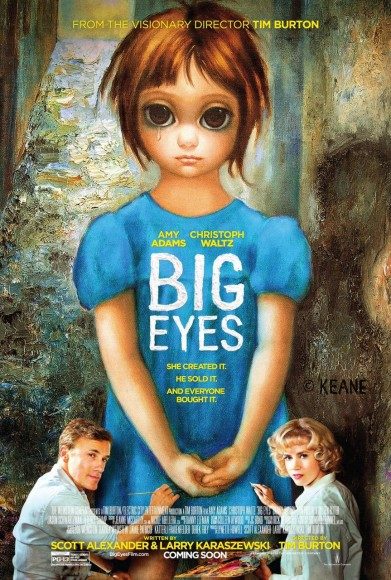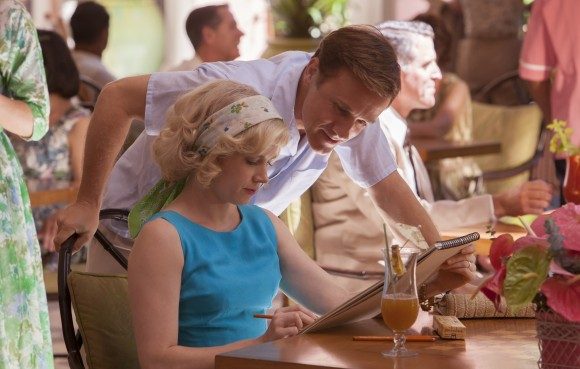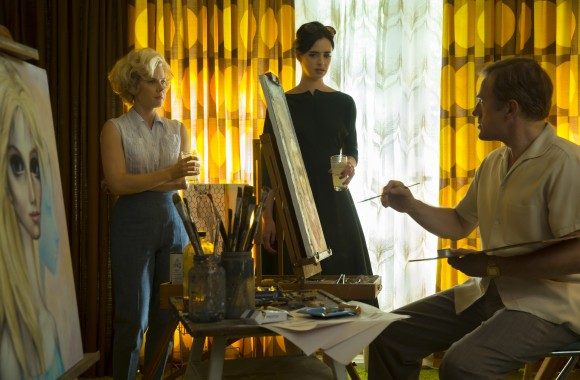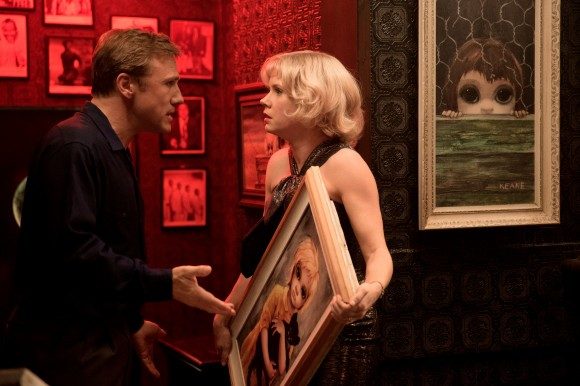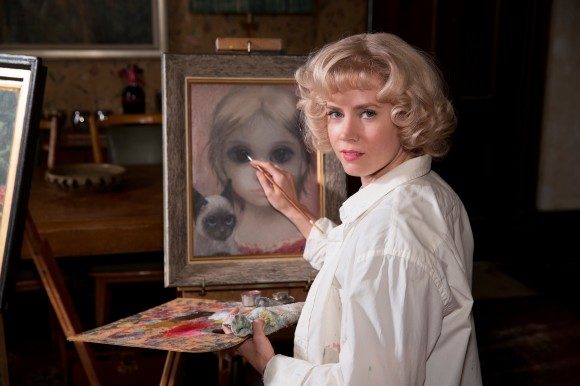There are times, and they come too few, when it seems like all the little pieces of a film come together into a cohesive whole. These movies aren’t necessarily the best of the best, but there’s something satisfying about the feeling that the director, and actors, and score, and design, and script were all matched well to one another. Such is the case for Big Eyes, which draws upon a true story that, as one of the writers put it, “If it weren’t true, I wouldn’t believe it.” That’s a cute and slightly clichéd statement, but as with Big Eyes as a whole, it cuts both ways – the “cuteness” is apparent but endearing, and it does nothing to minimize the astounding truth it describes.
The story is that of Walter (Christoph Waltz), and more importantly Margaret Keane (Amy Adams), who in the 1950s and ‘60s took the art world by storm with paintings of children featuring abnormally large eyes. Walter was credited as the painter of these works, with Margaret nothing more than the doting wife; but in reality, Margaret was the one with the artistic talent, and Walter nothing more than a gifted salesman. The film begins just before their meeting and runs through the eventual public reveal that it was not, in fact, Walter who had painted the “Big Eyes,” making most of the movie a character study with a focus on the way they worked together (often not as amicably as that sounds) to perpetrate this grand deception.
What’s most striking about this movie, and a big part of what makes it feel so cohesive, is the visual design that director Tim Burton and Co. have brought to Big Eyes. Just as the idea that a husband and wife would or could fool the public as they did seems ludicrous, the color palette of the film walks the line between the real and the hyperreal. 1950s San Francisco appears as this bohemian mecca just a little too strange to be true…but then again, it is San Francisco, and Margaret stands embodied before us, bleach-blonde hair and all. There’s a conscious effort that’s been made to mimic the slightly unsettling but also beautiful oeuvre of a Keane big-eyed waif (as they’re frequently referred), and it unifies the production. Even in the opening titles, shots of Margaret fleeing her failed first marriage seem like they might be just a hair too bright for life, until painted titles blaze across the screen as if to say, “No, this is what bright looks like.” Whether set off by the moody lighting of a darkened nightclub or amidst the sunshine of a Hawaiian neighborhood, Big Eyes is consistently a luscious visual treat.
But all that would be for nothing if not for the performances by Waltz and Adams. Waltz finds himself typecast here, reprising the verbose, smarmy charm that won him Oscars for Django Unchained and Inglorious Basterds, but it’s perfect for the character of Walter. Walter is constantly unsettling for the viewer, a little too forward here, a little too suggestive there, but Waltz manages to show a front likable enough that we immediately believe how a lonely Margaret, not to mention the general public, might be wooed by him. I’m ready to see Waltz in a different type of character altogether, but it’s hard to hold a feeling of overfamiliarity against him too much.
Amy Adams, on the other hand, positively shines as Margaret. Much of Adams’s career to date has been as one sort of young professional woman or another; even last year’s American Hustle gave her a decidedly youthful tilt. Big Eyes, on the other hand, calls for a more matured woman, even as Margaret herself is admittedly naïve early in the film. Margaret also has the greater arc of the two principles, going from a scared young single mother to a confident woman disillusioned with her husband’s surface-level charm. It’s in this change that Adams brings Margaret to life. Early incredulity at Walter taking credit for her work gives way to delight over the financial success, but this proves unsustainable to her as Margaret is increasingly isolated, even from her own daughter. It’s a subtle performance, but one that’s spot on at every scene.
Burton’s influence on the visual design of Big Eyes is palpable, but he and writers Scott Alexander and Larry Karaszewski also deserve credit for couching the entire story in some very compelling thematic material. It’s not stuff that necessarily adds a lot of weight to the story itself, which is continuously focused on Margaret and Walter as a couple, but does provide a nice backdrop for the plot. First and foremost are the gender politics of mid-20th century America. As the movie’s intro says, Margaret left her first husband before it was “stylish” to do so, but found herself facing an uphill battle when it came to making a living and maintaining custody over her daughter. Walter is initially a savior, giving her financial and social security she’d have difficulty finding otherwise in the 1950s.
Quite separately, Walter’s influence on popular art (he heavily marketed the waif paintings, licensing and reprinting the images to sell them to the masses) is beyond debate, but the artistic merit of the paintings themselves has been hotly contested through the years. Although Terrence Stamp makes a brief (but memorable) appearance as art critic John Canaday, Big Eyes chooses not to wade too deeply into the nuances of art criticism, instead returning the conversation to the Keanes. To Margaret, her paintings are her “children,” full of meaning and painted with purpose. Walter’s capitalistic appropriation of her work seems to preclude any conversation about the artistic merit of the pieces themselves, instead invoking the argument of popular appeal. Again, it’s not something that Big Eyes is overly concerned with debating, but the thematic background makes the movie all the richer.
The Verdict: 4 out of 5
Big Eyes may not quite soar to any unseen heights in narrative or theme, but the movie is an absolute treat for just how well it all fits together. The production takes its inspiration from is subject, Margaret Keane’s “Big Eyes” paintings, and mirrors their intersection of reality and something just beyond through each piece of its telling. Amy Adams is great as Margaret, and Tim Burton feels like the perfect fit for the story, bringing in his distinct aesthetic flair. The biggest criticism likely to be leveled at Big Eyes is that it trades a little heavily in Hollywood happy endings, but this should be overlooked easily enough. Big Eyes is a feel good film, and it’s does plenty to earn it’s positive outlook.

